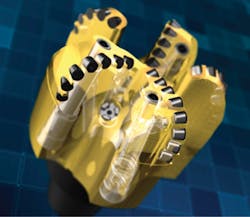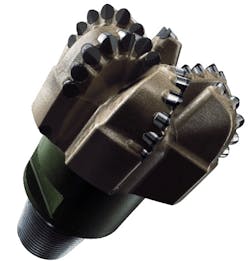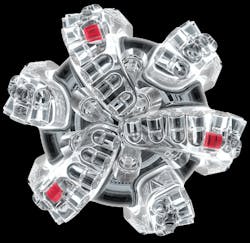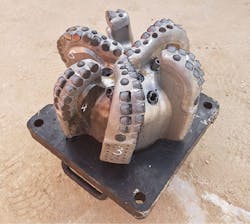Drillbit manufacturers are adding multidimensional cutter technologies and small moving parts to fixed diamond-cutter bits to create what they call smarter, stronger bits that recognize different rock layers. Operators focused on US shale plays previously used bits with no moving parts but now seek higher efficiency.
The bit design changes provide more consistent rates of penetration (ROP) and longer bit life. Manufacturers say improved bit designs can be used onshore or offshore. The technology does not have to be customized for a specific play although bit sizes will vary depending on the job.
New bit designs mitigate stick slip, which results from vibrations or torsion that cause quick acceleration and deceleration of the drillstring and bit. The drillbit can stick while the string twists. Stick slip damages equipment, decreasing productivity and increasing drilling costs.
Baker Hughes earlier this year announced the TerrAdapt adaptive drill bit, featuring self-adjusting depth-of-cut (DOC) elements. The polycrystalline diamond compact (PDC) bit automatically adjusts to different rock layers without surface intervention by engineers.
DOC elements move up or down for smooth transitions through different rock types.
Smith Bits, a Schlumber company, released the AxeBlade ridged diamond element bit to improve ROP across various formations and steering response in directional drilling.
The bit's cutting element breaks rock with 30% less force than conventional PDC bits. Its specially designed ridge shape combines the shearing action of a conventional PDC bit with the crushing action of a roller cone bit, Schlumberger said.
Halliburton released its Cruzer technology, which includes rolling elements at the bit tip, to help maintain DOC control while reducing equipment wear and tear.
NOV ReedHycalog recently launched the Chainsaw configuration with its Tektonic drillbit line, incorporating new ION 3D cutter technology. The cutter technology features a pointed cutting-edge to increase drilling efficiency. The configuration delivers higher ROP than conventional bits.
ExxonMobil Corp. early this year awarded Pason Systems Inc. a global license for ExxonMobil's patented Drilling Advisory System, which is part of the oil company's FastDrill technology.
BH's adaptive bit
Baker Hughes, a GE company, initially used the TerrAdapt bit in the Delaware basin in Reeves County, Tex., where an operator reported erratic drilling performance in 12¼-in. intermediate sections running through interbedded shale, limestone, and salt.
Extreme torque fluctuations and stick slip hindered drilling efficiency and caused downhole tool failures. The operator contacted Baker Hughes to complete the next sections quicker by mitigating stick slips and reducing impact loading.
The adaptive drill bit completed a 3,355-ft section in one run, increasing ROP by 27% compared with offset wells drilled using standard PDC bits. The adaptive bit's ROP averaged 168 fph. Surface torque was 45% lower on average and 90% more consistent than standard PDC bits.
Stability improved, with fewer vibrations contributing to straighter wells drilled faster, said Scott Schmidt, Baker Hughes' vice-president of drill bits. Drillers completed the section with no damage to the bottomhole assembly (BHA).
Industry typically prevents stick slip by setting a fixed DOC and by adjusting the weight-on-bit or rpm.
Conventional bits limit operators to one DOC control setting. Drilling through different rock layers causes torsional vibrations and stick slip. Torsional oscillations result in erratic ROP.
Rotation adjustments while drilling can cause abnormal vibrations, potentially damaging BHA equipment.
Automatic adaptive technology assists drilling engineers address circumstances the bit is encountering 10,000 ft downhole. The DOC elements extend or retract upon encountering different rock hardnesses (Fig. 1).
When torsional vibrations are detected, the bit's elements extend to maintain stable drilling. The elements retract upon resumption of smooth drilling.
Baker Hughes added moving parts to its fixed bit that adapt by extending or retracting as the bit moves through layers of different rock hardness to mitigate stick slip. Photo from Baker Hughes. (Fig. 1).
Schmidt compared it to a vehicle's seat belt. "If you yank on it, it resists. But if you gradually pull it, it will move," he said.
Cartridges in the bit blades contain the DOC elements, which extend in milliseconds and fully retract within tenths of seconds, depending on how far they have extended. The replaceable cartridges, designed for multiple runs, feature a moving piston assembly that controls DOC. Each cartridge moves independently within the bit blade.
Schmidt said the self-adjusting bit could become an industry standard that likely will be used in more drilling jobs than just wells where stick slip might be an issue. He expects future development efforts will be geared toward expanding smart bit capabilities.
Schlumberger's ridged bit
AxeBlade represents the latest generation of Smith Bits three-dimensional cutting technologies (Fig. 2).
In the South Texas Eagle Ford play, the bit kicked off from vertical to a 90° angle and drilled a lateral section for a 3,586-ft interval in 35 hr. The ROP was 102.5 fph, 29% faster than offset wells.
The bit held its toolface and build angle. It reduced reactive torque compared with baseline bits and showed better dull condition compared with offset runs.
Shell used the bit to drill 5,353 ft in 24 hr offshore Louisiana with lower torque fluctuations, improving ROP by 100% compared with the field's median. The bit and PowerDrive Orbit RSS drilled 13,674 ft in 45 hr and an average on-bottom ROP of 305 ft/hr through a long salt section, building the angle from 0° to 42°.
Pemex used a multiactivation reamer and the ridged diamond element bit to save 48 hr and $240,000 in trip-related costs on a Gulf of Mexico exploratory well. The bit completed the operation in one trip.
Kuwait Oil Co. used Schlumberger's bit to increase ROP while drilling through formations where KOC previously encountered severe stick slip. Drillers increased ROP by 84% vs field-average ROP. Total depth was achieved in one run, saving an entire drilling day and $32,600.
The diamond table on the element ridge is 70% thicker than that of a conventional cutter, providing increased frontal impact resistance. The bit delivers improved durability and dull condition for maximum ROP throughout the run, Schlumberger said.
Unit Petroleum Co. increased ROP 27% using the bit in an intermediate section targeting the Anadarko basin's Granite Wash onshore Texas. The ridged diamond-element enabled drilling with 20% less torque and 27% higher ROP through interbedded shale, sand, and limestone.
Halliburton's rolling elements
Halliburton used its Cruzer technology in the Williston basin in North Dakota. An operator drilled a horizontal well's curve in 14 hr-the fastest run of any offset well in the area. Reduced wear on the bit contributed to higher ROP.
Small diamond rolling elements on the bit face lowered the coefficient of friction. These elements can be replaced or repaired. The system features abrasion resistance, impact resistance, thermal mechanical integrity, and maintains DOC control throughout the bit run.
The rolling elements allow more stabilized control during directional drilling. Their small size allows them to be incorporated into new or existing designs (Fig. 3).
Lower friction levels reduce generated heat, improving drilling efficiency and bit reliability, said Brad Dunbar, Halliburton's product manager, drill bits.
"The bit engages the formation at a very constant rate without taking energy away from the cutting structure," Dunbar said.
He said the goal is to combine smarter bits with drilling rig technology that eventually will digitally sense changing rock structures before the bit reaches them for a seamless, automated drilling process. "Otherwise, everything is reactionary," Dunbar said.
Smith Bits AxeBlade ridged-shaped geometry enables removal of more formation for higher ROP and better trajectory control in directional applicatons. Photo from Schlumberger. (Fig. 2).
NOV's ION cutter
National Oilwell Varco (NOV) said it continues to advance in its ReedHycalog Tektonic drillbits.
Conventional cutters are effective in ductile formations, but they lack the diversity required for brittle, interbedded formations. NOV said ION 3D cutters work better than conventional cutters in:
• Sandstone and other clastic formations.
• Carbonates requiring a cutter shape that can fracture and shear.
• Shales and clays requiring shearing action.
Polished cutters allow cuttings to cross the diamond face without sticking, minimizing friction, generating less heat, and increasing drilling efficiency, NOV said
NOV said Hess selected multiple ReedHycalog bits to drill a horizontal well in the Bakken formation in McKenzie County, ND, from surface casing to TD using five BHAs. An 8 ¼-in. bit with thermally resistant, polished ION cutters was selected to drill the top-hole vertical section.
Halliburton Corp. designed its Cruzer depth-of-cut rolling element with a bit design that allows operators to increase ROP at a lower cost per foot for improved drilling economics. Photo from Halliburton. (Fig. 3).
An 8 ¾-in. Chainsaw bit with both ION and ION 3D cutters was used for the bottomhole section. A 6-in. Chainsaw drilled the horizontal section
Hess drilled the 6,424-ft top-hole vertical in 35 hr, or 184 fph, and drilled the 1,937-ft bottomhole vertical in. 15 hr, or 129 fph. Drillers completed a 9,715-ft horizontal section in 49.6 hr, or 196 fph.
NOV has also developed SoftSpeed II software that uses automated vibration dampening to mitigate torsional vibration and reduce stick-slip oscillations.
A North Sea operator encountered extreme stick slip in the 8½-in. horizontal section of one well, with severity close to 100%. This level of drilling vibration is inefficient and damages equipment.
The operator coped with this level of stick-slip severity for 9 hr, drilling at an average 62.3 fph before implementing the SoftSpeed II system. ROP was increased to 68.9 fph, allowing the rig to drill about 1.5 extra stands that day.
An NOV engineer trained the drilling crew on the software, linked to a real-time technology center for constant monitoring. The operator received daily reports on stick-slip severity by depth. Reports also listed calibrations and tuning specifics. The reports confirmed ROP and torque properly correlated with downhole conditions.
Total E&P Norge AS is developing an oil field that includes several deep, structurally complex, high-pressure gas and condensate reservoirs. Total is drilling wells with restricted pressure windows using SoftSpeed II stick-slip prevention services.
NOV's ReedHycatlog designed the Tektonic drill bit to maximize ROP while using the least amount of energy. Engineers sought ways to minimize frictional losses associated with cuttings movement up the cutter face and along the blade. Photo from NOV. (Fig. 4).
Technology, standards
A new licensed ExxonMobil technology automates drilling in real time by integrating proprietary modeling with data analytics. ExxonMobil said use of the system has improved its drilling performance at nine fields.
T.H. Hill, a Bureau Veritas standards-setting firm, in 2016 updated the DS-1 inspection procedures and acceptance criteria for drillbits. The DS-1 BITS standard involves separate categories for new bits and used bits.
Bit manufacturers provide inspections as do bit users. T.H. Hill provided photographs along with updated acceptance criteria, showing what is acceptable or unacceptable in a simplified inspection process.
About the Author
Paula Dittrick
Senior Staff Writer
Paula Dittrick has covered oil and gas from Houston for more than 20 years. Starting in May 2007, she developed a health, safety, and environment beat for Oil & Gas Journal. Dittrick is familiar with the industry’s financial aspects. She also monitors issues associated with carbon sequestration and renewable energy.
Dittrick joined OGJ in February 2001. Previously, she worked for Dow Jones and United Press International. She began writing about oil and gas as UPI’s West Texas bureau chief during the 1980s. She earned a Bachelor’s of Science degree in journalism from the University of Nebraska in 1974.





